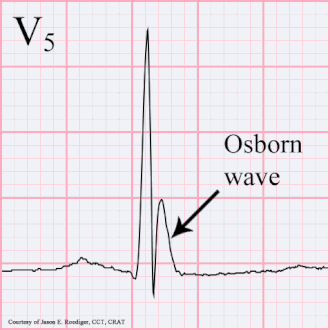J wave
Electrocardiographic finding associated with hypothermia and other conditions
J wave[edit]
The J wave, also known as the Osborn wave, is a distinctive deflection seen on the electrocardiogram (ECG) that occurs at the junction between the QRS complex and the ST segment. It is characterized by a positive deflection immediately following the QRS complex, often best observed in the inferior and lateral leads of the ECG.

History[edit]
The J wave was first described by John J. Osborn in 1953, who identified it as a marker of hypothermia. Since then, it has been associated with various other clinical conditions, including hypercalcemia, brain injury, and early repolarization syndrome.
Pathophysiology[edit]
The exact mechanism of the J wave is not fully understood, but it is believed to be related to the differential repolarization of the epicardial and endocardial layers of the heart. In hypothermia, the J wave is thought to result from altered ion channel function at lower body temperatures, particularly affecting the sodium and calcium channels.
Clinical Significance[edit]
The presence of J waves on an ECG can be a critical diagnostic clue in the context of hypothermia, where they are often referred to as "Osborn waves." In this setting, they are typically seen when the core body temperature drops below 32°C (89.6°F). However, J waves can also appear in normothermic patients with other conditions, such as Brugada syndrome, where they may indicate an increased risk of ventricular fibrillation and sudden cardiac death.
Associated Conditions[edit]
- Hypothermia: The classic association, where J waves are most prominently observed.
- Hypercalcemia: Elevated calcium levels can lead to the appearance of J waves.
- Neurological injury: Conditions such as subarachnoid hemorrhage can also produce J waves.
- Brugada syndrome: A genetic disorder that affects cardiac sodium channels, leading to characteristic ECG changes including J waves.
- Early repolarization syndrome: A benign condition that can mimic the appearance of J waves on an ECG.
Diagnosis[edit]
The diagnosis of a J wave is made through careful analysis of the ECG. It is important to consider the clinical context, as the presence of J waves can have different implications depending on the underlying condition. In hypothermia, the J wave is a key diagnostic feature, while in other conditions, it may warrant further investigation to assess the risk of arrhythmias.

Management[edit]
Management of patients with J waves depends on the underlying cause. In hypothermia, rewarming the patient is the primary treatment, which often leads to the resolution of J waves. In cases where J waves are associated with arrhythmogenic conditions like Brugada syndrome, specific antiarrhythmic therapies and lifestyle modifications may be necessary.
Prognosis[edit]
The prognosis for patients with J waves varies widely based on the underlying condition. In hypothermia, prompt rewarming can lead to a good outcome, while in conditions like Brugada syndrome, the risk of sudden cardiac death may necessitate more aggressive management strategies.
Related pages[edit]
Ad. Transform your life with W8MD's Budget GLP-1 injections from $75


W8MD offers a medical weight loss program to lose weight in Philadelphia. Our physician-supervised medical weight loss provides:
- Weight loss injections in NYC (generic and brand names):
- Zepbound / Mounjaro, Wegovy / Ozempic, Saxenda
- Most insurances accepted or discounted self-pay rates. We will obtain insurance prior authorizations if needed.
- Generic GLP1 weight loss injections from $75 for the starting dose.
- Also offer prescription weight loss medications including Phentermine, Qsymia, Diethylpropion, Contrave etc.
NYC weight loss doctor appointmentsNYC weight loss doctor appointments
Start your NYC weight loss journey today at our NYC medical weight loss and Philadelphia medical weight loss clinics.
- Call 718-946-5500 to lose weight in NYC or for medical weight loss in Philadelphia 215-676-2334.
- Tags:NYC medical weight loss, Philadelphia lose weight Zepbound NYC, Budget GLP1 weight loss injections, Wegovy Philadelphia, Wegovy NYC, Philadelphia medical weight loss, Brookly weight loss and Wegovy NYC
|
WikiMD's Wellness Encyclopedia |
| Let Food Be Thy Medicine Medicine Thy Food - Hippocrates |
Medical Disclaimer: WikiMD is not a substitute for professional medical advice. The information on WikiMD is provided as an information resource only, may be incorrect, outdated or misleading, and is not to be used or relied on for any diagnostic or treatment purposes. Please consult your health care provider before making any healthcare decisions or for guidance about a specific medical condition. WikiMD expressly disclaims responsibility, and shall have no liability, for any damages, loss, injury, or liability whatsoever suffered as a result of your reliance on the information contained in this site. By visiting this site you agree to the foregoing terms and conditions, which may from time to time be changed or supplemented by WikiMD. If you do not agree to the foregoing terms and conditions, you should not enter or use this site. See full disclaimer.
Credits:Most images are courtesy of Wikimedia commons, and templates, categories Wikipedia, licensed under CC BY SA or similar.
Translate this page: - East Asian
中文,
日本,
한국어,
South Asian
हिन्दी,
தமிழ்,
తెలుగు,
Urdu,
ಕನ್ನಡ,
Southeast Asian
Indonesian,
Vietnamese,
Thai,
မြန်မာဘာသာ,
বাংলা
European
español,
Deutsch,
français,
Greek,
português do Brasil,
polski,
română,
русский,
Nederlands,
norsk,
svenska,
suomi,
Italian
Middle Eastern & African
عربى,
Turkish,
Persian,
Hebrew,
Afrikaans,
isiZulu,
Kiswahili,
Other
Bulgarian,
Hungarian,
Czech,
Swedish,
മലയാളം,
मराठी,
ਪੰਜਾਬੀ,
ગુજરાતી,
Portuguese,
Ukrainian